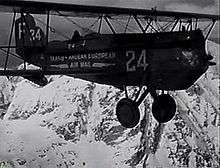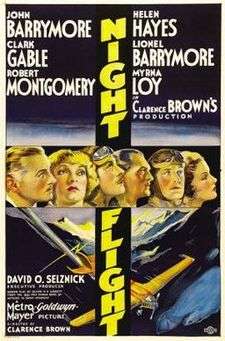Night Flight (1933 film)
| Night Flight | |
|---|---|
|
Night Flight theatrical poster | |
| Directed by | Clarence Brown |
| Produced by | David O. Selznick |
| Written by |
Oliver H.P. Garrett John Monk Saunders Antoine de Saint-Exupéry (novel: Vol de nuit) |
| Starring |
John Barrymore Lionel Barrymore Clark Gable Helen Hayes Robert Montgomery Myrna Loy |
| Music by |
Herbert Stothart Charles Maxwell (orchestrator) |
| Cinematography |
Elmer Dyer Charles A. Marshall Oliver T. Marsh |
| Edited by | Hal C. Kern |
| Distributed by | Metro-Goldwyn-Mayer |
Release dates |
|
Running time | 84 minutes |
| Country | United States |
| Language | English |
| Budget | $499,000[1] |
| Box office | $1,079,000[1] |
Night Flight (also known as Dark to Dawn) is a 1933 American pre-Code aviation drama film produced by David O. Selznick and distributed by Metro-Goldwyn-Mayer and directed by Clarence Brown. The film stars John Barrymore, Lionel Barrymore, Clark Gable, Helen Hayes, Robert Montgomery and Myrna Loy.[2]
It is based on the 1931 novel of the same name which won the Prix Femina the same year, by French writer and pioneering aviator Antoine de Saint-Exupéry.[N 1] Based on Saint-Exupéry's personal experiences while flying on South American mail routes, Night Flight recreates a 24-hour period of the operations of a fictional airline based on Aéropostale, Trans-Andean European Air Mail.[4][N 2]
In 1942, Night Flight was withdrawn from circulation as a result of a dispute between MGM and Saint Exupéry. Its public re-release had to wait until 2011, when legal obstacles were overcome.[6]
Plot
In South America, the daunting mountains and dangerous weather have hampered the operations of Trans-Andean European Air Mail, a 1930s-era airline. Charged with delivering a serum to stem an outbreak of infantile paralysis in Rio de Janeiro, Auguste Pellerin (Robert Montgomery) conquers his fears, but is reprimanded by the airline's stern director, A. Riviére (John Barrymore) for coming in late.
Determined to make the night flight program work, Riviére has sent pilot Jules Fabian (Clark Gable) and his wireless operator on another dangerous flight. The pair are caught in a torrential rain storm and when Madame Fabian (Helen Hayes) comes to the headquarters, she realizes that her husband is overdue. The two airmen, flying blind over the ocean, run out of fuel and choose to jump but are drowned.
Riviére refuses to quit and orders a Brazilian pilot (William Gargan) to take the mail to Rio, but the pilot's wife (Myrna Loy) pleads with him not to go. Despite the dangers, the night mail is delivered on time. The pilot despairs that his flight only meant that someone in Paris can get a postcard on Tuesday instead of Thursday, but its real value is proven when the serum is also delivered and a child is saved.
Cast
- John Barrymore as A. Riviére
- Lionel Barrymore as Robineau
- Clark Gable as Jules Fabian
- Helen Hayes as Madame Fabian
- Robert Montgomery as Auguste Pellerin
- C. Henry Gordon as Daudet
- William Gargan as Brazilian pilot
- Myrna Loy as wife of Brazilian pilot
- Leslie Fenton as Jules' radio operator
- Harry Beresford as Roblet
- Dorothy Burgess as Pellerin's girlfriend
- Irving Pichel as Dr. Decosta
- Helen Jerome Eddy as worried mother
- Ralf Harolde as Pilot
- Marcia Ralston as nightclub vamp
Production

Saint Exupéry's Vol de nuit, based on real-life events in South America, had won the 1931 Prix Femina, one of the main French literary prizes (awarded by a female jury).[4] Prior to this award, he had been little known outside of the literary sphere, but as a result of the prize, received widespread recognition and attention from Hollywood.[7]
Selznick realized that Oliver H.P. Garrett's original treatment was too heavily based on "the ground" and brought in John Monk Saunders, who had worked with him on The Dawn Patrol (1930), to add more flying scenes.[8] Director Clarence Brown was dissatisfied with that version, so Selznick finally called on writer Wells Root to tighten up the final draft. Brown also was interested in an accurate portrayal of aviation, as he had been a World War I pilot. Night Flight utilized both studio and location shooting with the mountainous region around Denver, Colorado, filling in for the South American Andes.[9] The recently retired U.S. Mail Douglas M-4 mail planes were featured as the Trans-Andean European Air Mail's primary aircraft.[10]
Reception
MGM's choice of an all-star cast was intended to elevate Night Flight to epic status.[11] The film, however, was sequenced in episodic style with many of the scenes concentrating on one of the sub-plots; Gable's scenes, for example, featured his fateful last flight, primarily filmed in the cockpit without spoken dialog. Most of the sequences were filmed in isolation with little interaction between the lead actors.[12] Although premiered in a longer, two-hour version,[6] the final film was received favorably by critics. The New York Times review called it "a vivid and engrossing production."[13] In a similar vein, Variety considered Night Flight, "a competently done saga".[14] Despite the favorable reviews, however, Night Flight was considered a disappointment at the box office.[6]
Smarting from some critics' reviews of his novel, and professing that he hated the film adaptation, Saint Exupéry refused to renew his author's rights, which he had granted to MGM only for a 10-year period.[15] In 1942, Night Flight was pulled from circulation when MGM's agreement with Saint Exupéry expired.[16][N 3]
Following its first public showing at the 2011 TCM Classic Film Festival, a first-time home video of the picture was released on DVD on June 7, 2011, over 75 years after its original release.[16] The movie's world television premiere was on TCM on August 10, 2012.[18]
Box office
According to MGM records, Night Flight earned $576,000 in the U.S. and Canada and $503,000 elsewhere, resulting in a profit of $176,000.[1]
See also
References
Notes
- ↑ During World War II, Count Antoine de Saint-Exupéry took to writing his name with a hyphenated last name; prior to that period, only his literary works had this form.[3]
- ↑ The film adaptation of Night Flight (originally Vol de nuit) was the first of Saint-Exupéry's novels to be adapted for the screen.[4][5]
- ↑ On July 31, 1944, Saint Exupéry disappeared over the Mediterranean while flying for the Armée de l'Air (French Air Force) and was believed to have died at that time.[17]
Citations
- 1 2 3 "The Eddie Mannix Ledger." Margaret Herrick Library, Center for Motion Picture Study, Los Angeles reprinted in Popular Filmgoing in 1930s Britain: A Choice of Pleasures By John Sedgwick p 147-148
- ↑ Hanson and Gevinson 1993, Volume 3.
- ↑ "Saint Exupéry (de)." Archived September 28, 2007, at the Wayback Machine. Armorial de l'ANF; retrieved August 24, 2012.
- 1 2 3 Schiff 2006, p. 210.
- ↑ "Filmography: Antoine de Saint-Exupéry", IMDb.com; retrieved August 22, 2012.
- 1 2 3 Lumenick, Lou. "Movies DVD Extra: Lost 'Flight' surfaces after 78 years." The New York Post, June 7, 2011. Retrieved: August 12, 2012.
- ↑ Steinberg, Jay S. "Night Flight (1933)." Turner Classic Movies, 2012. Retrieved: August 11, 2012.
- ↑ Haver 1980, pp. 133–134.
- ↑ "Night Flight: Filming Locations." IMDb. Retrieved: August 11, 2012.
- ↑ Francillon 1979, p. 103.
- ↑ Lumenick, Lou. "Long-MIA ‘Night Flight’ (1933), ‘Constant Nymph’ (1943) due on DVD after TCM bows." New York Film Critics Circle, February 14, 2011. Retrieved: August 19, 2012.
- ↑ Schiff 2006, p. 220.
- ↑ Hall, Mordaunt. "Night Flight (1933): John and Lionel Barrymore, Helen Hayes and others in a pictorial adaptation of 'Night Flight'." The New York Times, October 7, 1933. Retrieved: August 12, 2012.
- ↑ "Night Flight." Variety, December 31, 1932. Retrieved: August 12, 2012.
- ↑ Lumenick, Lou. "DVR Alert: Lee Tsiantis and 'Caught' on TCM." The New York Post, March 17, 2011. Retrieved: August 12, 2012.
- 1 2 King, Susan. "TCM Classic Film Festival: 'Night Flight,' 'The Constant Nymph,' 'Hoop-La'." Los Angeles Times, April 28, 2011. Retrieved: August 12, 2012.
- ↑ Schiff 2006, p. 451.
- ↑ Night Flight (DVD). Hollywood, California: WarnerVideo.com, 2011. ISBN 0-7806-7493-6.
Bibliography
- Francillon, René J. McDonnell Douglas Aircraft since 1920. London: Putnam, 1979. ISBN 0-370-00050-1.
- Hanson, Patricia King (Executive Editor) and Alan Gevinson (Associate Editor). The American Film Institute Catalog of Motion Pictures Produced in the United States: 1931-40, Feature Films. Berkeley, California: University of California Press, 1993. ISBN 978-0-52007-908-3.
- Haver, Ronald. David O. Selznick's Hollywood. London: Martin Secker & Warburg Ltd., 1980. ISBN 978-0-43619-128-2.
- Schiff, Stacy. Saint Exupéry: A Biography. New York: Holt, 2006, First edition by De Capo, 1993. ISBN 978-0-80507-913-5.
External links
- Night Flight at the TCM Movie Database
- Night Flight at the Internet Movie Database
- Night Flight at AllMovie
- The AFI Catalog of Feature Films:..Night Flight
